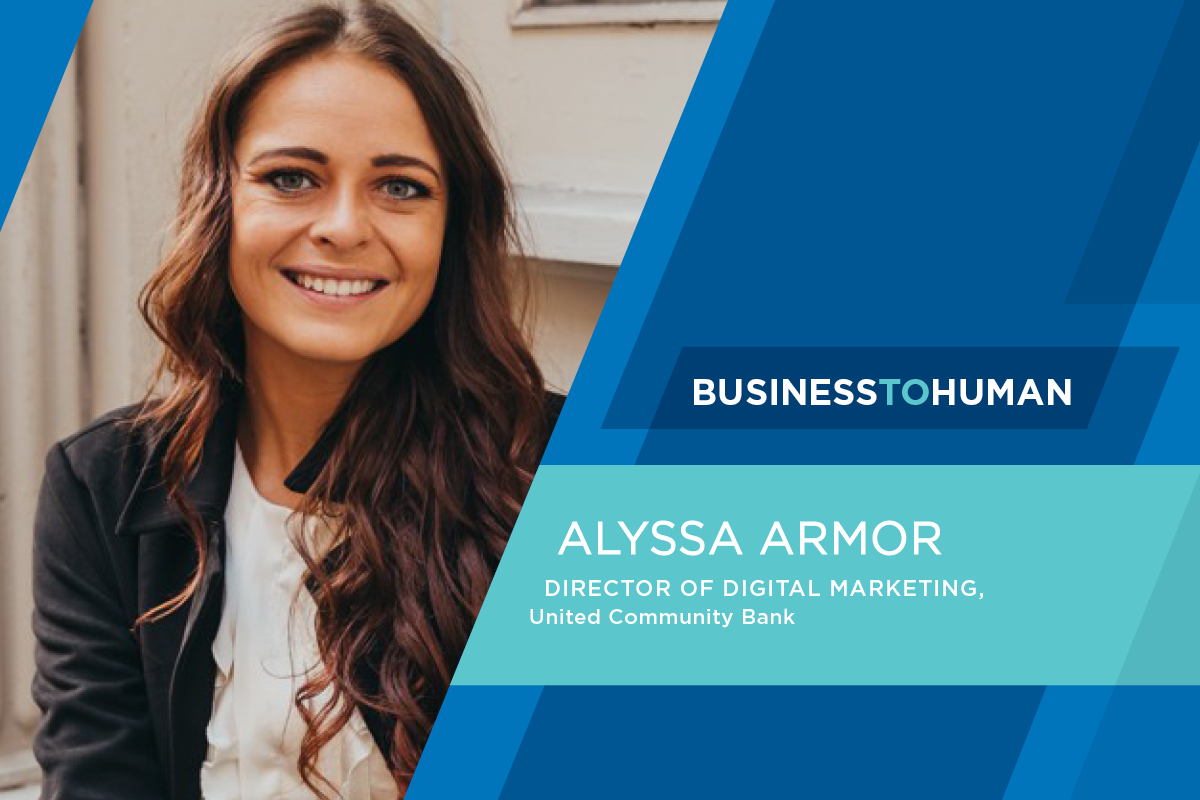What is the why guiding your business? Regardless of industry, an organization needs a strong North Star to orient its teams behind. Without a well-defined — and socially sound — why powering the actions of your team, your business is destined to falter, especially in trying times.
As the world shifts through a transitionary period, from pandemic to economic downturn, many businesses are in a unique position to evolve. Whether or not they choose to adapt can influence their trajectory for decades to come.
We spoke with Alyssa Armor, Director of Digital Marketing at United Community Bank about her unique experience navigating the quickly-shifting environment in the financial sector about what’s to come, and what we can learn from the past several years.
According to her and many experts, banking must take the opportunity to adapt.
A crystal ball glimpse into the future
Even the most informed experts lack a clear picture of the future of the financial industry. But faced with the current volatile environment, Alyssa says everyone is on the edge of their seats — both with concern and excitement.
Business leaders and consumers alike are reflecting on the restrictionless pre-pandemic world within the context of current uncertainty. Everyone is asking what the future holds. Unfortunately, not every business will make it out on the other side of the economic downturn.
To survive and thrive in the future, there are three major factors banks need to keep in mind:
First, only the strongest brands will survive
There needs to be a relentless focus on differentiating, establishing and strengthening your brand. A resounding pattern keeps arising — mergers and acquisitions are rampant. Banks continue to consolidate.
“53% of people don’t find a specific value proposition at their bank,” Alyssa says. “There’s nothing above and beyond that their bank does that others don’t.”
Without a strong differentiator, people are willing to switch banks in a heartbeat, even after years of being loyal to a specific bank or branch. Make sure your bank is deepening customer relationships, offering value people can’t find anywhere else and continues to align strategy with what your bank is good at.
“Traditional banking products are not innately unique — checking accounts, saving accounts — you can get those anywhere,” Alyssa says. “Those extra bells and whistles on top will be what saves your business.”
Second, intentionally designing driving principles will make or break your experience
The guiding principles behind your bank — your why — is something that is immensely important to today’s customers. More importantly, they can easily sense whether or not your driving purpose is authentic.
“Humanizing the brand is so incredibly important,” Alyssa says. “For example, Gen Z will not do business with you if they are not aligned with your values.”
A strong why can’t be built around a balance sheet or returns — it must be grounded in principles that will resonate with the public. It’s critical to tap into your target demographic to understand what drives their banking practices, what matters to them and how you can incorporate that into your strategy. Once a guiding principle or mission has been established, you have to effectively communicate it to incorporate it into the customer experience.
But your ‘why’ can’t be pushed by your marketing team alone. It has to be established, defined and communicated from the top to the bottom. Every person across your organization must align with your driving principles to truly provide an experience tailored to your mission. In short — you can’t just announce your ‘why,’ you have to live by it business-wide.
“Living your why really effectively on all of your channels and making sure people understand that why from the top all the way down and can effectively communicate it to customers at every step of the journey is so incredibly important,” Alyssa says.
Third, a strong foundation is necessary for success
While there’s a current influx in M&A, it will eventually slow down. However, this doesn’t mean those who made it through without a consolidation will be safe just yet. To thrive on the other side of this chapter of economic uncertainty, banks will need to have a strong foundation to build upon.
That foundation is rooted in the guiding principles of your organization and in the experience you’ve built for your customers.
“When you try to scale, the cracks will begin to show if your brand and technology stack aren’t rock-solid,” Alyssa says. “All the different departmental silos need to be broken down for you to do business effectively across an organization.”
Breaking down department silos is often easier said than done. A great step in the right direction is ensuring that your systems all work together — particularly as MarTech and FinTech solutions become more diverse.
“You’re going to end up with disparate systems that don’t always play nice,” Alyssa says. “Bringing all of that together holistically creates a machine that effectively empowers our marketing and business.”
Building a relentless focus on the customer experience
Customers look at your business as a synergistic entity — they don’t separate the on-location experience from the app or digital experience. In the end, each part of your business has to work together to build an ideal customer experience.
“Customers don’t care if you have a random third party managing one specific product line if they’re being bumped from one website to another,” Alyssa says. “It’s one brand, it’s one holistic experience. It needs to be seamless.”
Above all else, banks need to build customer relationships in everything they do. From tech stack selections to partnership opportunities and on-location experiences, the entire organization must deliver a stellar journey guided by a strong, relatable ‘why’ that is embedded across every facet of their bank.
Want to learn more about surviving the turbulent current state and thriving in the future of banking business? Listen on Apple Music®, Spotify®, or your preferred podcast platform.
